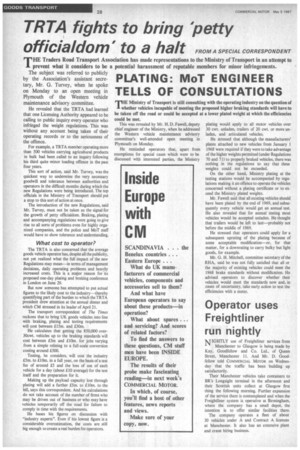PLATING: MoT ENGINEER TELLS OF CONSULTATIONS
Page 30

If you've noticed an error in this article please click here to report it so we can fix it.
FruE Ministry of Transport is still consulting with the operating industry on the question of I whether vehicles incapable of meeting the proposed higher braking standards will have to be taken off the road or could be accepted at a lower plated weight at which the efficiencies could be met.
This was revealed by Mr. H. D. Fawell, deputy chief engineer of the Ministry, when he addressed the Western vehicle maintenance advisory committee's well-attended open meeting in Plymouth on Monday.
He reminded operators that, apart from exemptions for special cases .which were to be discussed with interested parties, the Ministry plating would apply to all motor vehicles over 30 cwt. unladen, trailers of 20 cwt. or more unladen, and articulated vehicles.
He stressed that although the manufacturers' plates attached to new vehicles from January 1 1968 were required if they were to take advantage of the higher weights permitted (under Regulations 70 and 71) to properly braked vehicles, there was nothing in the regulations to say that these weights could not be exceeded.
On the other hand, Ministry plating at the testing stations would be accompanied by regulations making it an offence to operate the vehicles concerned without a plating certificate or to exceed the Ministry plated weights.
Mr. Fawell said that all existing vehicles should have been plated by the end of 1969, and subsequently every vehicle would get an annual test. He also revealed that for annual testing most vehicles would be accepted unladen. He thought that trailers would be left to last—probably not before the middle of 1969.
He stressed that operators could apply for a subsequent uprating of the plating because of some acceptable modification—or, for that matter, for a downrating to carry bulky but light goods, for example.
Mr. G. H. Mitchell, committee secretary of the RHA, said he was not fully satisfied that all or the majority of existing vehicles could meet the 1968 brake standards without modification. He advised operators to discover whether their vehicles would meet the standards now and, in cases of uncertainty, take early action to test the efficiencies with a meter.




















































































































